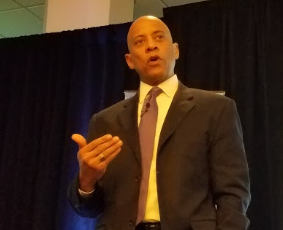DHS aims to use IoT, analytics to boost smart city resiliency

Dr. Reginald Brothers, Under Secretary for Science & Technology at the U.S. Dept. of Homeland Security, said his agency is focused on infrastructure resiliency, Internet of things (IoT) warning networks and analytics to help first responders.

DHS' Dr. Reginald Brothers
Speaking at the Smart Cities Summit in Boston, Brothers also urged better public-private partnerships with the DHS.
"We are hard to work with," said Brothers, who added that DHS is creating innovation programs for smaller companies that don't regularly work with the government. Proposals have also been streamlined to 10 pages and after that first cut there's a 15 minute proposal.
The overall theme for Brothers was the role of the DHS and technology in the context of smart cities. To make technology work in communities there will need to be better public-private partnerships. "How do we help cities and communities understand what technology can do?" asked Brothers. "And how do we help private businesses understand what communities need."
One focus for the DHS is using IoT and analytics to enable decision-making for first responders. "Making decisions is the biggest problem," said Brothers. For instance, during flooding officials have to make decisions to tell residents to either remain in place or evacuate. "We have to make sure that decision is as accurate as possible," said Brothers.
Add it up and smart cities, IoT and analytics will combine to provide situational awareness. "We want to get to a place where smart cities recognize first responders," he said.
In the end, the DHS is becoming more tech savvy. Brothers said DHS has created projects for cheap water sensors for water safety. The agency is also linking technologists with cities and first responders in the field to collaborate better.